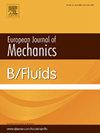径向磁场对非对称加热/冷却垂直环空自由对流产生霍尔电流的数值研究
IF 2.5
3区 工程技术
Q2 MECHANICS
引用次数: 0
摘要
霍尔效应是一个多世纪前发现的,它在各个部门仍然很重要,而且越来越重要。其应用范围从技术进步到医疗技术,其中霍尔电流现象对于优化性能和推动创新至关重要。霍尔效应在当代系统中的持续整合凸显了其在研究和工业中的持久价值。为了延续这种持久的相关性,我们研究了受径向磁场影响的垂直同心圆柱体中霍尔电流的影响,外部圆柱体不对称加热或冷却。采用Crank-Nicolson方法求解控制系统的偏微分方程,分析了各种无量纲参数影响下的流体温度、速度和表面摩擦力,并以图形和表格的形式给出了结果。用不同的数值方法验证输出,并根据现有文献进行验证,以确保结果的准确性和可靠性。研究表明,在r=1.5时,径向磁场产生的霍尔电流比常规磁场产生的霍尔电流强约15%。然而,由于径向磁场的方向依赖于径向轴,因此与传统磁场相比,径向磁场对减少流体流动的影响较小。当浮力参数在0≤R<;1范围内时,最大速度集中在内筒附近,向外筒减小,而在R=1时,最大速度向中心区域移动,呈抛物线状。本文章由计算机程序翻译,如有差异,请以英文原文为准。
Numerical study of Hall currents induced by radial magnetic fields on free convective flow through asymmetrically heated/cooled vertical annuli
The Hall effect, discovered over a century ago, continues to be significant and increasingly relevant across various sectors. Its applications range from technological advancements to medical technology, where Hall current phenomena are essential for optimizing performance and driving innovation. The ongoing integration of Hall effects into contemporary systems highlights its enduring value in both research and industry. In continuation of this enduring relevance, we studied the influence of Hall currents in vertical concentric cylinders subjected to a radial magnetic field, with the outer cylinder asymmetrically heated or cooled. The governing system of partial differential equations was solved using the Crank–Nicolson method to analyze fluid temperature, velocity, and skin friction under the influence of various dimensionless parameters, with results presented through both graphical and tabular perspectives. The outputs are verified with different numerical methods and validated against existing literature to ensure the accuracy and reliability of the results. The study reveals that the Hall current induced by the radial magnetic field is approximately 15% stronger than that generated by a conventional magnetic field at . However, the radial magnetic field has a lesser impact in reducing fluid flow compared to the conventional magnetic field, due to its directional dependence on the radial axis. Furthermore, when the buoyancy force parameter is in the range , the maximum velocity is concentrated near the inner cylinder and decreases towards the outer cylinder, whereas at , the maximum velocity shifts towards the central region and takes a parabolic shape.
求助全文
通过发布文献求助,成功后即可免费获取论文全文。
去求助
来源期刊
CiteScore
5.90
自引率
3.80%
发文量
127
审稿时长
58 days
期刊介绍:
The European Journal of Mechanics - B/Fluids publishes papers in all fields of fluid mechanics. Although investigations in well-established areas are within the scope of the journal, recent developments and innovative ideas are particularly welcome. Theoretical, computational and experimental papers are equally welcome. Mathematical methods, be they deterministic or stochastic, analytical or numerical, will be accepted provided they serve to clarify some identifiable problems in fluid mechanics, and provided the significance of results is explained. Similarly, experimental papers must add physical insight in to the understanding of fluid mechanics.

 求助内容:
求助内容: 应助结果提醒方式:
应助结果提醒方式:


